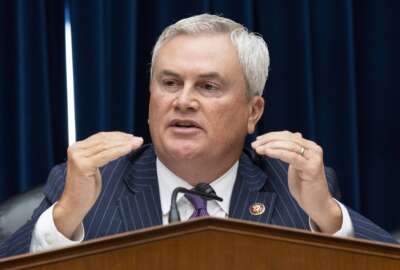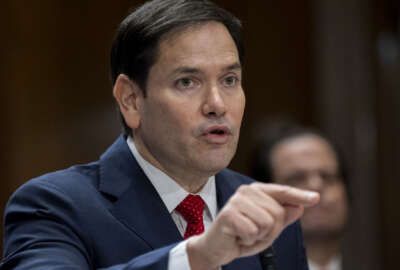A snapshot of where most copyright claims are coming from
"We want to understand these patterns better to help us better identify the socioeconomic factors," Michael Palmedo said.
A new study for the U.S. Copyright Office looks at the geographic distribution of copyright claims registered within the United States. The agency is hoping to get a sense of where the copyright system is used and how patterns of registrations differ across areas within the country. For more on what they found and how the office will use this information, Federal News Network’s Jared Serbu spoke with Michael Palmedo, a statistician with the Copyright Office on the Federal Drive with Tom Temin.
Interview transcript:
Michael Palmedo Well, the purpose of the report is for the office and other key copyright stakeholders to better understand where the copyright system is really being used and how patterns of registration, copyright registrations, vary or differ across areas within the country. We want to understand these patterns better to help us better identify the socioeconomic factors that influence creative and innovative activity and commercial activity from the firms that use the copyright system. The analysis and the report then enhances our understanding of what’s going on, and we have a better understanding of the commercial activities supported by copyright and a better idea of how registrants tend to clustered together in certain areas.
Jared Serbu And beyond just coming up with a lot of interesting data, which it is, and we’ll talk about it, what can the office itself actually do with that information once you have it in terms of better meeting your mission?
Michael Palmedo Well, we’ve actually already begun using the data to help our public information and outreach team with their work. When they go to do outreach in an area they know who are some of the main the biggest registrants, and is this area more likely to have registrations of artistic works or literary works, that sort of information. And then also the broader purpose of the report is to help both us and other key copyright stakeholders better understand the geography of the copyright system and hopefully use that to build on for great further research.
Jared Serbu So let’s talk about some of the findings. And I guess let’s start with agglomeration. A bit of clustering you found, more than a bit of clustering. Talk about that. Talk about that aspect of what you found.
Michael Palmedo Yeah. Well, I should say that there are copyright registrations throughout the country. And as a matter of fact, there is only one county in the country that had zero registrations during the period we studied, which was 2009 to 2022, that said the majority of copyright registrations do originate from a handful of large metropolitan areas. Ten metropolitan areas generate slightly more than half of the country’s copyright registrations, and 40% of all copyright registrations originate from just five, which are New York, Los Angeles, Philadelphia, D.C. and Chicago. And these are the metropolitan areas, which include the suburbs that are connected to the urban core. We also see copyright registrations, we’ll we see this clustering is actually consistent with urban economic literature that describes how people and firms become more productive when they cluster together. This happens because they benefit from exchanging knowledge and resources amongst themselves. We also see that in the registration data that regions tend to specialize in different types of creative works. So you have registrants in the Northeast and the mid-Atlantic registering the most copyrights for written works. You see registrants in California specializing in film and dramatic works, and registrants in the South are more likely to register works of music or sound recordings. And finally, when you control for population, you find numerous locations where individuals, companies and universities are registering a lot of creative works at a big rate, which you wouldn’t find if you had the total count. Then you miss very population drift. But when you look per person, there are all these little pockets of creativity. You see lots of music publishers and small towns making use of copyright system, consumer product firms registering claims on their on line media content. And you see trade associations protecting online databases, that sort of thing.
Jared Serbu And in terms of the top metro areas, I mean, given everything you just said, the top two are not surprising to me in New York and L.A. Number three, I probably wouldn’t have guessed if you’d told me to do so, the Philadelphia metro area, not to put you on the spot, but any sense of what types of works tend to be responsible for that Philadelphia area being number three.
Michael Palmedo There’s a lot of academic publishing coming out of Philadelphia. Not only is there a few universities there, there’s also a big publisher, I forget which one, but there’s a lot of different academic publishers and universities in that particular metropolitan area.
Jared Serbu And getting back to making use of some of those data, I wonder if it’s possible to get a handle on works that are eligible for copyright but not registered. Are you able to see clusters of creative activity that’s not taking advantage of the copyright system, and maybe try to better serve those types of communities or those types of creative artists.
Michael Palmedo Our data, what the Copyright Office has is data on works that are registered. In our research, not in this report, we are comparing that to BLS data on employment by occupation and industry with the goal of finding areas where we don’t have a lot of registrations, but we do have people that are working either in occupations or industries where they could better benefit from the copyright system.
Jared Serbu Interesting. And are you getting any sense yet of where that outreach activity needs to be targeted based on that comparison between your data and the BLS data?
Michael Palmedo At this point, it’s in process. I can’t say what we’ve found yet, but we are looking into that for reach purposes.
Jared Serbu Makes sense. All right. Any other high points from the research that you wanted to mention before we let you go?
Michael Palmedo OK. Well, there were definitely some surprises in the data. To create this report, we spent a lot of time poring over registrations data that hadn’t gotten as much attention because the Office of the Chief Economist is a relatively new office. But when we looked at that, bunch of surprises and the artistic for instance so there is a large number of registrations for advertisements, which doesn’t mean that most firms register copyrights on their ads, but many do. We also saw a lot of registrations for artworks that were actually for clothing and textiles, both in Los Angeles and New York City. You have large textile and garment industries which use copyright systems to protect their designs. Which to me it shows that registration of artworks is important not just for artists, because it can help facilitate commerce. And then just the final word would probably be it was fun to see all these neat little areas that you wouldn’t think of as having really vibrant, creative sectors that do like small towns with a few active registrants like Winona, Minnesota, for instance. There’s a lot of musical works being registered there, and I never would have thought of that if it wasn’t for this exercise of really poring through the data.
Jared Serbu Your factoid earlier about only one county having no registrations is really interesting to me considering the number of extremely small counties we have out there.
Michael Palmedo Absolutely.
Copyright © 2025 Federal News Network. All rights reserved. This website is not intended for users located within the European Economic Area.
Tom Temin is host of the Federal Drive and has been providing insight on federal technology and management issues for more than 30 years.
Follow @tteminWFED






